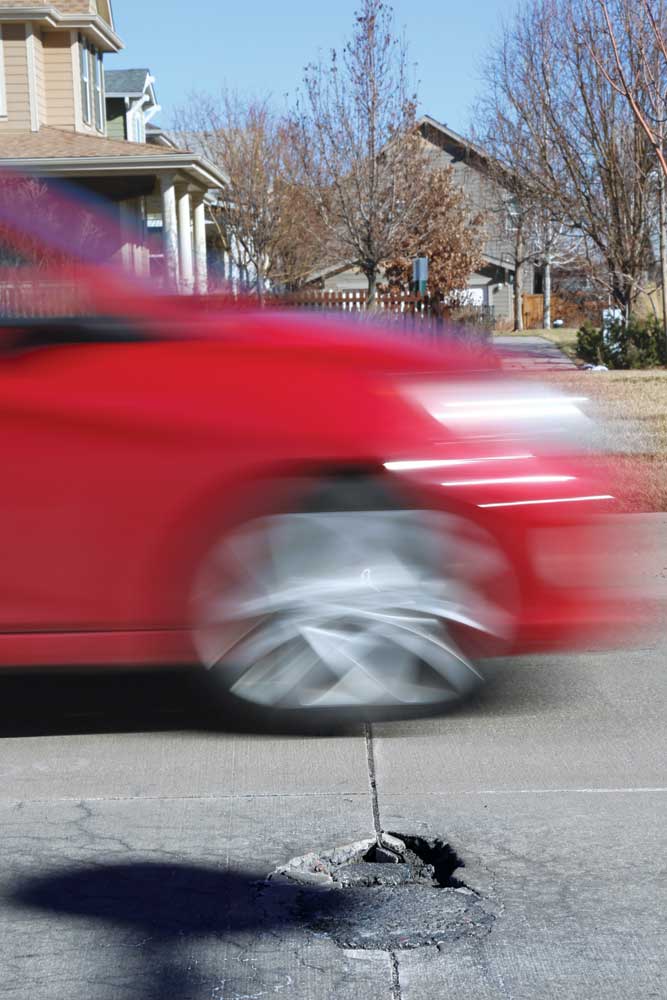 Ka-thunk! Potholes regularly jar Coloradans’ winter and spring commutes. And they’re becoming more abundant. Hundreds of thousands are repaired every year, at an annual cost of $8 to $25 apiece. Ka-ching!
Ka-thunk! Potholes regularly jar Coloradans’ winter and spring commutes. And they’re becoming more abundant. Hundreds of thousands are repaired every year, at an annual cost of $8 to $25 apiece. Ka-ching!
Our roads develop more potholes than most other states. Even on newish residential streets like mine, alligator cracks quickly become potholes—yawing open to gobble up dirt, wayward Legos, and the occasional dog paw.
A generation or two ago, Colorado had fewer potholes per mile of road—despite the fact that street pavements weren’t as highly engineered as today. To a minor extent, that’s because roads didn’t have as much deferred maintenance as today’s byways. But this is only part of the story.
Yesteryear’s roads were less traveled, speeds were slower, vehicle weights lighter, and there were fewer trucks per capita using our streets. Not to mention there was no Amazon Prime.

A car on Central Park Blvd. passes one of many potholes plaguing Denver roads after cycles of freeze and thaw.
These factors are relevant because the impact of vehicles on pavement’s pre-existing weaknesses is what triggers and then exacerbates opening of potholes. That impact is mostly governed by how fast tires hit the pavement, how much weight is riding on a tire and how hard the tire is. For example, truck tires, inflated to 100 psi, are tougher on pavement than are most 32 psi car tires. Tires cooled by winter temperatures are more rigid and hit pavement harder than do tires warmed by summer heat.
Today’s trucks are heavier, drive faster and travel more on local streets and highways than a half-century ago. Many are overweight. Cars are also heavier, have tougher tires and travel at generally higher speeds than back in the day.
Put these factors together, and potholes blossom. Moreover, each municipal bus, 18-wheeler or garbage truck can have between one and 5,000 times the impact of a car on the road. FedEx and UPS trucks have about a hundred times a car’s impact.
The road type can also make a difference: interstates and major intersections are usually 10”-thick concrete, whereas most highways and urban streets are asphalt. Both use a mix of gravel, pebbles and/or sand, held together by cement or tar. Major arterials might have 12”-thick beds of asphalt atop a roadbed of crushed rock or sand, whereas residential streets might only have 2”–3” pavement.
But the big kahuna of pothole production is our climate. That’s because our high-elevation weather is dominated by regular oscillations above and below the freezing point of water (32° F). Our winter and spring days are often warm(ish) and sunny. This makes our winters enviable—but frequent daily forays above freezing followed by subfreezing nights combine to wreak havoc on our roads.
Warm winter and spring days allow water from rain and melted snow to drip down cracks in the pavement and enter the soil that underlies the concrete or asphalt. Once below the pavement, cool nighttime or next-day temperatures cause the water to freeze. Frozen water expands by about 10 percent—enough for a subsurface puddle to buckle the pavement upward a bit. Once the soil thaws out, it slumps back to its original position, but the buckled pavement doesn’t. All it takes is the right whack of a tire to dislodge a chunk of the weakened roadway. The same thing happens in cracks, which gradually get wedged open more and more.
Potholes tend to form where these weaknesses experience heavy traffic. They can also form where a pre-existing weakness exists, such as where two different road types intersect, like where asphalt meets a concrete gutter, manhole cover, or intersection walkway. But the most common roadbed weakness that leads to potholes is where streets are cut by utilities, contractors or developers.
Colorado has a team of road wranglers that keep potholes from getting out of control. Prevention is the first tool in their saddlebag—they beat potholes to the punch by sealing cracks or embalming alligator-skin streets with oily slurries. Where roads are beyond such preventative maintenance, they strike a middle ground by scraping off the top of the road like a hockey-rink’s Zamboni, and redepositing it with some new asphalt and goo. But many years it’s hard to keep up with the demand for road maintenance and replacement, so as the pavement ages and fails, they also play pothole whack-a-mole. In rushed or stormy situations they mash asphalt into holes as quickly as they can—usually only as a temporary fix. But at other times, they use a giant snorkeled machine whose snout uses infrared light to warm the pavement and help pothole patches stick.
Given these factors, potholes seem like they will always be with us.
My only advice: if you’re about to hit one, just roll over it. Hitting the brakes compresses your suspension before or on top of the impact event. It’s about as helpful as tightening your arm muscles just before the nurse gives you a shot. Ouch!
James Hagadorn, Ph.D., is a scientist at the Denver Museum of Nature & Science.
Suggestions and comments are welcome at jwhagadorn@dmns.org.



0 Comments